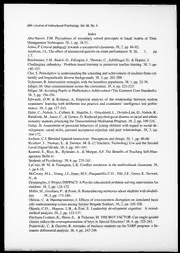
Journal of Instructional Psychology 2011: Vol 38 Index & Table of Contents PDF
Preview Journal of Instructional Psychology 2011: Vol 38 Index & Table of Contents
264 / Journal of Instructional Psychology, Vol. 38, No. 4 Index Abu-Nasser, F.M. Perceptions of secondary school principals in Saudi Arabia of Time Management Techniques. 38, l,pp. 18-31. Ainsa, P. Critical pedagogy towards a sociomoral classroom. 38,2, pp. 84-92. Azorlosa, J.L. The effect of announced quizzes on exam performance: II. 38, 1, pp 3-7. Blackboum, J.M., Bunch, D., Fillingim, J., Thomas, C., Schillinger, D., & Dupree, J. Challenging orthodoxy: Problem-based learning in preservice teacher training. 38,3, pp. 140-153. Chu, S. Perscriptive in understanding the schooling and achievement of students from cul¬ turally and linguistically diverse backgrounds. 38,3, pp. 201-209. Dykeman, B. Intervention strategies with the homeless population. 38,1, pp. 32-39. Ediger, M. Oral communication across the curriculum. 38,4, pp. 221-223. Ediger, M. Assisting Pupils in Mathematics Achievement (The Common Core Standards). 38,3,pp. 154-156. Edwards, O.W. & Rottman, A. Empirical analysis of the relationship between student examiners’ learning with deliberate test practice and examinees’ intelligence test perfor¬ mance. 38,3,pp.157-163. Elder, C., Nidich, S., Colbert, R., Hagelin, J., Grayshield, L., Oviedo-Lim, D., Nidich, R., Rainforth, M., Jones, C., & Gerace, D. Reduced psychological distress in racial and ethnic minority students practicing the Transcendental Meditation Program. 38,2, pp. 109-116. Gulay, H. Assessment of prosocial behaviors of young children with regard to social de¬ velopment, social skills, parental acceptance-rejection and peer relationships. 38, 3, pp. 164-172. Jochum, C J. Blended Spanish instruction: Perceptions and design. 38,1, pp. 40-46. Reinhart, J., Thomas, E., & Toriskie, M. K-12 Teachers: Technology Use and the Second Level Digital Divide. 38,3, pp. 181-193. Kazemi, E., Rice, B., Rylander, A., & Morgan, S.F. The Benefits of Teaching Self-Man¬ agement Skills to Students of Psychology. 38,4, pp. 235-241. LaCour, M. M. & Tissington, L.K. Conflict resolution in the multicultural classroom. 38, l,pp 8-10. McCreary, M.L., Young, JJ.,Jones, M.Y., Pasquarello,C.D., Fife,J.E.,Grosz, E., Stewart, N.,& Desmangles, J. Project IMPPACT: A Psycho-educational problem-solving intervention for children, 38,2, pp. 124-132. Miller, M., Gresham, R, & Fouts, B. Remembering memories about students with disabili¬ ties . 38,3,pp.173-180. Ohlson, C. & Hammermeister, J. Effects of concentration disruption on simulated basic rifle marksmanship scores among Stryker Brigade Soldiers. 38,2, pp. 105-108. Okpala, C.O., Hopson, L.B., & Fort, E. Leadership development expertise: A mixed- method analysis. 38,2, pp. 133-137. Piechura-Couture, K., Heins, E., & Tichenor, M. THE BOY FACTOR: Can single-gender classes reduce the overrepresentation of boys in Special Eduction? 38,4, pp. 255-263. Piotrowski, C. & Guyette, R. Attitudes of business students on the TARP program: a Se¬ mantic differential analysis. 38,4, pp. 242-246. Journal of Instructional Psychology, Vol. 38 , No. 4 .. / 265 Plata, M. Cultural schemata—Yardstick for measuring others: Implications for teachers. 38, 2,pp. 117-123. Poyrazli, S. & Hand, D.B. Using drawings as a pedagogical method to facilitate multicul¬ tural competency development. 38,2, pp. 93-104. Radhakrishnan, P., Schimmack, U., & Lam, D. Repeatedly answer questions that elicit inquiry-based thinking improves writing. 38,4, pp. 247-252. Ryan,T. E., Blau, S. & Grozeva, D. Teaching cognitive-behavioral therapy to undergradu¬ ate psychology students. 38,1, pp. 23-31. Sahin, S. & Yilmaz, H. A Confirmatory Factor Analysis of the Teaching and Learning Con¬ ceptions Questionnaire (TLCQ). 38,3, pp 194-200. Schulz, L.L. Targeting school factors that contribute to youth alienation: Focused school counseling programs. 38,2, pp. 75-83. Shawareb, A. The effects of computer use on creative thinking among Kindergarten chil¬ dren in Jordan. 38,4, pp. 213-220. Snell, J.C. & Marsh, M. Meta-analytic derivation. 38,4, pp. 253-254. Stefansson, G. & Sigurdardottir, A J. Web-assisted education: From evaluation to learning. 38, l,pp.47-60. Vallaire-Thomas, L., Hicks, J., & Growe, R. Solution-focused brief therapy: An interven¬ tional approach to improving negative student behaviors. 38,4, pp. 224-234. Ziadat, A.H., Abu-Nair, N.S., & Abu Sameha, M.A. Mechanisms and development strate¬ gies from the prospective of faculty members for teaching philosophies to improve pre¬ ferred thinking styles at Jordanian universities. 38,2, pp. 63-74. Zigarovich, K.L. & Myers, S.A. The relationship between instructor communicative char¬ acteristics and college students’ conflict-handling styles. 38,1, pp. 11-17. i I I I j i t '■■-it-'- , 1 ■ » 1
